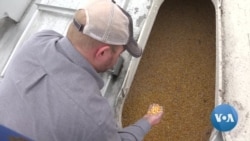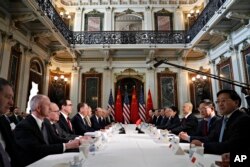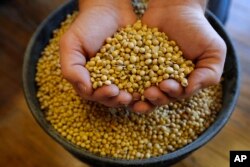ໝາກສາລີແລະຖົ່ວເຫຼືອງ ແມ່ນຜົນລະປູກທີ່ສ້າງກຳໄລຫຼາຍທີ່ສຸດໃຫ້ແກ່ຊາວສວນອາເມຣິກັນໃນແຕ່ລະປີ. ໃນຂະນະທີ່ພວກຊາວສວນຫຼາຍຄົນພາກັນປູກພືດສອງຊະນິດນີ້ ສັບປ່ຽນກັນໄປຕາມລະດູການ, ການຂັດແຍ້ງທາງການຄ້າກັບຈີນທີ່ມີຢູ່ໃນເວລານີ້ ໄດ້ສົ່ງຜົນກະທົບຕໍ່ແມ່ນແຕ່ການຕັດສິນໃຈໃນການດຳເນີນກິດຈະວັດປະຈຳວັນຂອງພວກຊາວສວນໃນເວລາທີ່ພວກເຂົາເຈົ້າມຸ້ງໜ້າໄປຫາສວນເພື່ອປູກເຄື່ອງປູກຂອງຝັງຂອງຕົນ ໃນລະດູໃບໄມ້ປົ່ງປີນີ້. ເຄນ ຟາຣາໂບ (Kane Farabaugh) ມີລາຍງານເພີ້ມເຕີມກ່ຽວກັບເລື້ອງນີ້ ຈາກລັດອີລີນອຍ, ທາງພາກຕາເວັນຕົກຕອນກາງຂອງສະຫະລັດ ຊຶ່ງວັນນະສອນ ມີລາຍງານມາສະເໜີທ່ານໃນອັນດັບຕໍ່ໄປ.
ໃນສວນຂອງທ່ານ Evan Hultine ທີ່ຢູ່ນອກເມືອງພຣິນສຕັນ ລັດອີລີນອຍ ນັ້ນ ການປູກໝາກສາລີແມ່ນມາແຮງ ເປັນອັນດັບນຶ່ງຂອງປີນີ້.
ທີ່ຈິງແລ້ວ ມັນເປັນຜົນລະປູກຢ່າງດຽວ ທີ່ທ່ານຈະໄດ້ເຫັນຢູ່ໃນສວນຂອງເພິ່ນ.
ທ່ານ Evan Hultine ຊາວສວນ ໃນລັດອີລີນອຍ ກ່າວວ່າ “ຈະບໍ່ມີການປູກໝາກຖົ່ວ
ເຫຼືອງເລີຍ ໃນປີນີ້ສຳລັບພວກເຮົາ. ຫຼັງຈາກສົງຄາມການຄ້າ ແກ່ຍາວມາເປັນເວລາ
ປະມານ 3 ເດືອນ ມັນກໍເປັນທີ່ຈະແຈ້ງແລ້ວວ່າ ທ່ານປະທານາທິບໍດີ ແມ່ນມີເປົ້າໝາຍ
ໄລຍະຍາວ ແລະໃນເວລານີ້, ພໍ່ຂອງຂ້ອຍ ແລະຂ້ອຍໄດ້ລົມກັນ ແລະພວກເຮົາກໍມີ
ຄວາມຮູ້ສຶກໝັ້ນໃຈຕໍ່ຄວາມສາມາດຂອງພວກເຮົາໃນການທີ່ຈະປູກໝາກສາລີໃຫ້ໄດ້
ຮັບຜົນສູງນັ້ນ ຫລາຍຂະໜາດເລີຍ.”
ການຕັດສິນໃຈຂອງທ່ານ Hultine ມີຂຶ້ນພາຍຫຼັງທີ່ມີຄວາມບໍ່ແນ່ນອນສຳລັບລາຄາ
ໝາກຖົ່ວເຫຼືອງເປັນປີ ຊຶ່ງໄດ້ກະທົບສ່ວນໃຫຍ່ຈາກການຂັດແຍ້ງທາງການຄ້າ ແລະພາ
ໃຫ້ຈີນຂຶ້ນພາສີຕໍ່ຜົນລະປູກທີ່ນຳເຂົ້າຈາກສະຫຼະລັດ ເພື່ອເປັນການຕອບໂຕ້ຕໍ່ການທີ່
ສະຫະລັດ ເກັບພາຕໍ່ເຫຼັກກ້າ ແລະອາລູມີນຽມ ທີ່ນຳເຂົ້າຈາກຈີນ ນັ້ນ.
ທ່ານ Hultine ກ່າວຕື່ມວ່າ “ພວກເຮົາຂາດທຶນຈາກປະມານ ນຶ່ງໂດລາເຄິ່ງ ຫາສອງ
ໂດລາ ຕໍ່ຖັງນຶ່ງ ຂຶ້ນກັບລາຄາຂອງແຕ່ລະມື້.”
ໃນຂະນະທີ່ມີການເຈລະຈາທາງການຄ້າລະຫວ່າງສະຫະລັດ ກັບຈີນຍັງສືບຕໍ່ ໂດຍທີ່
ບໍ່ມີການຕົກລົງກັນໃດໆ ຢູ່ນັ້ນ ຄວາມບໍ່ແນ່ນອນກໍຍັງມີສືບຕໍ່ໄປເຊັ່ນກັນ, ອີງຕາມ
ທ່ານ Michael Doherty ນັກເສດຖະສາດລະດັບສູງ, ຈາກຫ້ອງການດ້ານການເຮັດ
ສວນຂອງລັດອີລີນອຍ.
ທ່ານ Michael Doherty ກ່າວວ່າ “ພວກເຮົາກຳລັງເບິ່ງເຫັນວ່າລາຄາໝາກຖົ່ວ
ເຫລືອງຕາມທ້ອງຕະຫຼາດໃນອະນາຄົດຈະຂຶ້ນໆ ລົງໆ ໂດຍອີງຕາມຂ່າວຫຼ້າສຸດ
ທີ່ບອກວ່າພວກເຮົາມີຄວາມຄືບໜ້າຫຼືບໍ່? …ມັນແມ່ນຄວາມຈິງແທ້ບໍ ທີ່ວ່າ ພວກເຮົາ
ຈະກັບໄປມີສາຍພົວພັນທາງການຄ້າທີ່ປົກກະຕິກັບຈີນຄືນອີກ?”
ທ່ານ Doherty ກ່າວວ່າ ໝາກຖົ່ວເຫຼືອງຈຳນວນຫຼວງຫຼາຍຢ່າງເປັນປະຫວັດການ
ທີ່ຍັງລໍຖ້າໄວ້ຈະຂາຍ ຍິ່ງເຮັດໃຫ້ສະພາບການຍາກຍິ່ງຂຶ້ນສຳລັບພວກຊາວສວນ.
ທ່ານ Doherty ກ່າວເພີ້ມຕື່ມວ່າ “ພວກເຮົາມີໝາກຖົ່ວເຫຼືອງໃນສາງຂອງພວກເຮົາ
ໃນຕອນນີ້ ຫຼາຍກວ່າໝູ່ທີ່ສຸດເທົ່າທີ່ເຄີຍມີໃນປະຫວັດສາດຂອງສະຫະລັດ. ພວກເຮົາ
ແມ່ນນັ່ງຢູ່ເທິງກອງພູຂອງໝາກຖົ່ວເຫຼືອງ. ພວກເຮົາມີໝາກຖົ່ວເຫຼືອງ ຫຼາຍກວ່າ
ພັນລ້ານຖັງ ໃນສະຫະລັດ ແລະພວກເຮົາກໍຂາຍອອກມັນອອກ ໄດ້ຊ້າ ແລະໃນປະລິ
ມານທີ່ໜ້ອຍກວ່າປົກກະຕິທີ່ພວກເຮົາເຄີຍຂາຍ ໃນໄລຍະນີ້ ຂອງປີນຶ່ງໆ ນັ້ນຫລາຍ
ທີ່ສຸດ ແລະສະນັ້ນ ການສັ່ງຊາເບິ່ງຕະຫລາດ ກໍຄືການທີ່ມີປະລິມານໝາກຖົ່ວເຫຼືອງ
ຄ້າງໄວ້ຢູ່ໃນສາງເທົ່ານັ້ນ.”
ສຳລັບ ທ່ານ Hultine ການຕັດສິນໃຈທີ່ຈະບໍ່ປູກໝາກຖົ່ວເຫຼືອງນີ້ ບໍ່ແມ່ນເລື້ອງງ່າຍເລີຍ.
ທ່ານ Hultine ກ່າວວ່າ “ມັນຕ້ອງໄດ້ໃຊ້ທຶນໃນການປູກໝາກສາລີໃນເຮັກເກີນຶ່ງ ຫລາຍກວ່າການປູກໝາກຖົ່ວເຫຼືອງ ຫລາຍ, ສະນັ້ນ ພວກເຮົາຕ້ອງໄດ້ກູ້ຢືມເງິນ
ເພີ້ມອີກ ແລະດອກເບ້ຍກໍແມ່ນສູງຂຶ້ນຕິກໆ.”
ຄ່າໃຊ້ຈ່າຍໃນການຜະລິດສູງຂຶ້ນນັ້ນ ກໍໝາຍຄວາມວ່າໄດ້ຜົນກຳໄລໂດຍລວມ ຕ່ຳກວ່າ
ສຳລັບທ່ານ Hultine. ເຖິງແມ່ນວ່າກະຊວງກະສິກຳຂອງສະຫະລັດຄາດຄະເນວ່າ ຈະມີ
ລາຍຮັບເພີ້ມຂຶ້ນໃນລະດັບພໍປານກາງສຳລັບພວກຊາວສວນໃນປີນີ້, ແຕ່ທ່ານ Doherty
ແມ່ນບໍ່ມີຄວາມຫວັງໄປໃນແງ່ບວກເລີຍ.
ທ່ານ Doherty ກ່າວເພີ້ມຕື່ມວ່າ “ຂ້າພະເຈົ້າຄາດວ່າ ເມື່ອພວກເຮົາມອງເບິ່ງໃນປີ
2019 ນີ້ແລ້ວ ພວກເຮົາກໍຈະເຫັນວ່າ ມັນເປັນປີນຶ່ງທີ່ມີລາຍໄດ້ທີ່ໜ້ອຍທີ່ສຸດໃນຮອບ
5 ຫລື 6 ປີຜ່ານມາ.”
ທ່ານ Hultine ຫວັງວ່າ ສິ່ງອື່ນທັງຫຼາຍ ທີ່ເພິ່ນບໍ່ສາມາດຄວບຄຸມມັນໄດ້ ເຊັ່ນ ດິນຟ້າ
ອາກາດ, ຈະເປັນໃຈກັບເພິ່ນ ເພື່ອວ່າການຕັດສິນໃຈຂອງເພິ່ນທີ່ຈະປູກພຽງແຕ່ໝາກສາລີເທົ່ານັ້ນ ຈະເປັນການຕັດສິນໃຈທີ່ເພິ່ນຈະບໍ່ເສຍໃຈ.
ທ່ານ Hultine ກ່າວມ້ວນທ້າຍວ່າ “ມີແຕ່ເວລາເທົ່ານັ້ນ ຈະເປັນເຄື່ອງພິສູດ.”
ອ່ານຂ່າວນີ້ເພີ້ມຕື່ມເປັນພາສາອັງກິດ
Corn and soybeans are the most profitable crops for American farmers each year.While many rotate these two crops season to season, the ongoing trade dispute with China is impacting even routine decisions for farmers as they head to the fields this spring to plant.VOA's Kane Farabaugh has more from the Midwest state of Illinois.
On Evan Hultine's farm outside Princeton, Illinois, corn is king this year.
In fact, it's the only crop you'll see in his fields.
Evan Hultine, Illinois Farmer:
"No beans this year for us. After about three months of the trade war it was pretty clear that the President had long terms goals in mind and at the time, my Dad and I had talked, and we were way more comfortable with our ability to produce high yield corn."
Hultine's decision comes after a tumultuous year for soybean prices, affected mostly by the trade dispute and resulting tariffs China imposed on the crop in retaliation to U.S. tariffs on imported Chinese steel and aluminum.
Evan Hultine, Illinois Farmer:
"We lost anywhere from about a dollar fifty to two dollars a bushel depending on the day."
As trade talks between the U.S. and China continue without an agreement, so does the uncertainty says Illinois Farm Bureau economist, Michael Doherty.
Michael Doherty, Senior Economist, Illinois Farm Bureau:
"You are watching the futures market price for soybeans fluctuate based on the latest news of whether or not we're making progress… is it real that we are going to get back to a normal trading relationship with the Chinese?"
Doherty says the record amount of soybeans still waiting to be sold makes the situation even more difficult for farmers.
Michael Doherty, Senior Economist, Illinois Farm Bureau:
"We have more beans in storage right now than we ever had in the history of the United States.We are sitting on a mountain of soybeans. We have well over a billion bushels of soybeans in the United States and we are selling it far less rapidly and in smaller volumes than we normally would at this point of the year, and so that's weighing the market simply to just have the gigantic inventory of soybeans."
For Evan Hultine, the decision to skip the beans isn't an easy one.
Evan Hultine, Illinois Farmer:
"It takes so much more capital to raise an acre of corn than it does an acre of beans, so we had to borrow more money, and interest rates are rising."
Higher costs mean lower overall profits for Hultine.And while the U.S. Department of Agriculture forecasts a modest increase in overall farm incomes this year, Doherty isn't as optimistic.
Michael Doherty, Senior Economist, Illinois Farm Bureau:
"I would expect that we will have one of the worst farm income years we've had out of the last five or six years is what we're looking at in 2019."
Hultine hopes that everything else he can't control, like the weather, works in his favor so his decision to only plant corn isn't one he'll regret.
Evan Hultine, Illinois Farmer:
"Time will tell."












